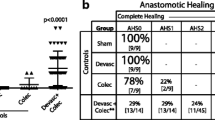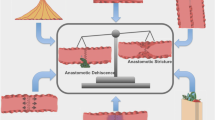Abstract
PURPOSE: The aim of this study was to compare the distribution of the matrix metalloproteinases (MMPs) during anastomotic healing in a normal colon with that in an ischemic colon in a rabbit. This family of enzymes degrades all components of connective tissue and has been implicated as a cause of anastomotic dehiscence. METHODS: A left-sided anastomosis was formed in the distal colon of one group of rabbits, and in the other group, 9 cm of distal colon was made ischemic before resection and anastomosis 12 hours later. Tissues from the anastomosis and sites around the colon were removed at 12 hours, 1 day, and 3 days after anastomosis and, also, at 7 days in the normal group. Distribution of the MMPs and their inhibitor, tissue inhibitor of metalloproteinases (TIMP), was localized by indirect immunofluorescence. RESULTS: In rabbits having only an anastomosis, the MMPs and TIMP-1 were, at all times, seen solely in the anastomotic segment and were strictly confined to the immediate vicinity of the suture line. While in rabbits with an ischemic colon before anastomosis, the MMPs initially extended several centimeters proximally and distally from the suture line. By the third day, however, there were only minor differences between the two models. CONCLUSION: Distribution of the MMPs and TIMP-1 in normal healing is consistent with a role in the remodeling of colonic anastomosis, but when healing of the colon is compromised, these en2ymes are more widespread and may contribute to anastomotic dehiscence.
Similar content being viewed by others
References
Fielding LP, Stewart-Brown S, Blesovsky L, Kearney G. Anastomotic integrity after operations of large bowel cancer: a multicenter study. BMJ 1980;281:411–4.
The Consultant Surgeons and Pathologists of the Lothians and Borders Health Boards. Lothian and Borders large bowel cancer project: immediate outcome after surgery. Br J Surg 1995;82:888–90.
McArdle CS, Hole D. Impact of variability among surgeons on postoperative morbidity and mortality and ultimate survival. BMJ 1991;302:1501–5.
Schrock TR, Deveney CW, Dunphy JE. Factors contributing to leakage of colonic anastomoses. Ann Surg 1973;177:513–8.
Hawley PR, Page Faulk W, Hunt TK, Dunphy JE. Collagenase activity in the gastrointestinal tract. Br J Surg 1970;57:896–900.
Cronin K, Jackson DS, Dunphy JE. Changing bursting strength and collagen content of the healing colon. Surg Gynecol Obstet 1968;126:747–53.
Irvin TT, Hunt TK. Reappraisal of the healing process of anastomosis of the colon. Surg Gynecol Obstet 1974;138:741–6.
Hendriks T, Vereecken TH, Hesp WL, Schillings PH, de Boer HH. Loss of collagen from experimental intestinal anastomoses: early events. Exp Mol Pathol 1985;42:411–8.
Jiborn H, Ahone NJ, Zederfeldt B. Healing of experimental colonic anastomoses. IV. Effect of suture technique on collagen metabolism in the colonic wall. Am J Surg 1980;139:406–13.
Hesp FL, Hendriks T, Lubbers E-J, de Boer HH. Wound healing in the intestinal wall: a comparison between experimental ileal and colonic anastomoses. Dis Colon Rectum 1984;27:99–104.
Chowcat NL, Savage FJ, Hembry RM, Boulos PB. Role of collagenase in colonic anastomoses: a reappraisal. Br J Surg 1988;75:330–4.
Murphy G, Reynolds JJ. Extracellular matrix degradation. In: Royse PM, Steinmann B, eds. Connective tissue and its heritable disorders. New York: Wiley-Liss & Sons, 1993;287–316.
Khoury GA, Waxman BP. Large bowel anastomoses. 1. The healing process and sutured anastomoses: a review. Br J Surg 1983;70:61–3.
Shandall A, Lowndes R, Young HL. Colonic anastomotic healing and oxygen tension. Br J Surg 1985;72:606–9.
Sheridan WG, Lowndes RH, Young HL. Tissue oxygen tension as a predictor of colonic anastomotic healing. Dis Colon Rectum 1987;30:867–71.
Senagore A, Milsom JW, Walshaw RK, Dunstan R, Mazier WP, Chaudry IH. Intramural pH: a quantitative measurement for predicting colorectal anastomotic healing. Dis Colon Rectum 1990;33:175–9.
van der Ham AC, Kort WJ, Weijma IM, van den Ingh HF, Jeekel H. Healing of ischemic colonic anastomosis: fibrin sealant does not improve wound healing. Dis Colon Rectum 1992;35:884–91.
Ahrendt GM, Tantry US, Barbul A. Intra-abdominal sepsis impairs colonic reparative collagen synthesis. Am J Surg 1996;171:102–8.
van der Ham AC, Kort WJ, Weijma IM, van den Ingh HF, Jeekel H. Effect of fibrin sealant on the integrity of colonic anastomoses in rats with faecal peritonitis. Eur J Surg 1993;159:425–32.
Nagase H, Brinckerhoff CE, Vater CA, Harris ED Jr. Biosynthesis and secretion of procollagenase by rabbit synovial fibroblasts: inhibition of procollagenase secretion by monensin and evidence for glycosylation of procollagenase. Biochem J 1983;214:281–8.
Hembry RM, Murphy G, Cawston TE, Dingle JT, Reynolds JJ. Characterization of a specific antiserum for mammalian collagenase from several species: immunolocalization of collagenase in rabbit chondrocytes and uterus. J Cell Sci 1986;81:105–23.
Gavrilovic J, Hembry RM, Reynolds JJ, Murphy G. Tissue inhibitor of metalloproteinases (TIMP) regulates extracellular type I collagen degradation by chondro-cytes and endothelial cells. J Cell Sci 1987;87:357–62.
Murphy G, Hembry RM, Reynolds JJ. Characterisation of a specific antiserum to rabbit stromelysin and demonstration of the synthesis of collagenase and stromelysin by stimulated rabbit articular chondrocytes. Coll Relat Res 1986;6:351–63.
Murphy G, Hembry RM, McGarritty AM, Reynolds JJ, Henderson B. Gelatinase (type IV collagenase) immunolocalization in cells and tissues: use of an antiserum to rabbit bone that identifies high and low Mr forms. J Cell Sci 1989;92:487–95.
Allan JA, Hembry RM, Angal S, Reynolds JJ, Murphy G. Binding of latent and high Mr active forms of stromelysin to collagen is mediated by the C-terminal domain. J Cell Sci 1991;99:789–95.
van der Stappen JW, Hendriks T, de Boer HH. Collagenolytic activity extracted from intestinal anastomoses of the rat. Matrix 1989;9:238–43.
Jonsson K, Jiborn H, Zederfeldt B. Mechanical and bio-chemical alterations in the intestinal wall adjacent to an anastomoses. Am J Surg 1986;151:387–90.
Stromberg BV, Klein L. Collagen formation during the healing of colonic anastomoses. Dis Colon Rectum 1982;25:301–4.
Brasken P, Lehto M, Renvall S. Changes in the connective tissue composition of the submucosal layer of colonic anastomoses. Acta Chir Scand 1989;155:413–9.
Novell JR, Lewis AA. Peroperative observation of marginal artery bleeding: a predictor of anastomotic leakage. Br J Surg 1990;77:137–8.
Orsay CP, Bass EM, Firfer B, Ramakrishnan V, Abcarian H. Blood flow in colon anastomotic stricture formation. Dis Colon Rectum 1995;38:202–6.
Author information
Authors and Affiliations
Additional information
Performed in the Department of Surgery, University College London Medical School, and supported by a grant to Dr. Lacombe by the Conselho Nacional de Desenvolvimento Cientifico e Tequinologico and Universidade federal do Rio de Janeiro, Brazil. The antisera to the matrix metalloproteinases and TIMP-1 were supplied by Drs. Reynolds and Hembry, Strangeways Research Laboratory, Cambridge, United Kingdom. Dr. Hembry is funded by the Medical Research Council, United Kingdom.
About this article
Cite this article
Savage, F.J., Lacombe, D.L.P., Boulos, P.B. et al. Role of matrix metalloproteinases in healing of colonic anastomosis. Dis Colon Rectum 40, 962–970 (1997). https://doi.org/10.1007/BF02051206
Issue Date:
DOI: https://doi.org/10.1007/BF02051206




